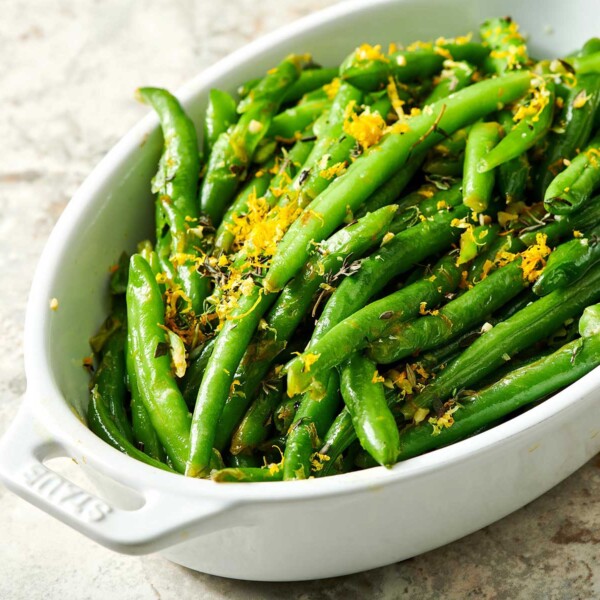How to Cook Fresh Green Beans
Updated Nov 03, 2025
This post may contain affiliate links. Please read our disclosure policy.
This simple stovetop method for cooking fresh green beans gives you vibrant, crisp-tender results every time. After trimming the beans, sauté them briefly in butter or oil, then add a little broth (or water), and cover to steam briefly. Remove the lid and let the liquid evaporate so the beans finish with a light glaze. It’s an effortless side dish that complements everything from weeknight pork chops to the turkey on Thanksgiving.
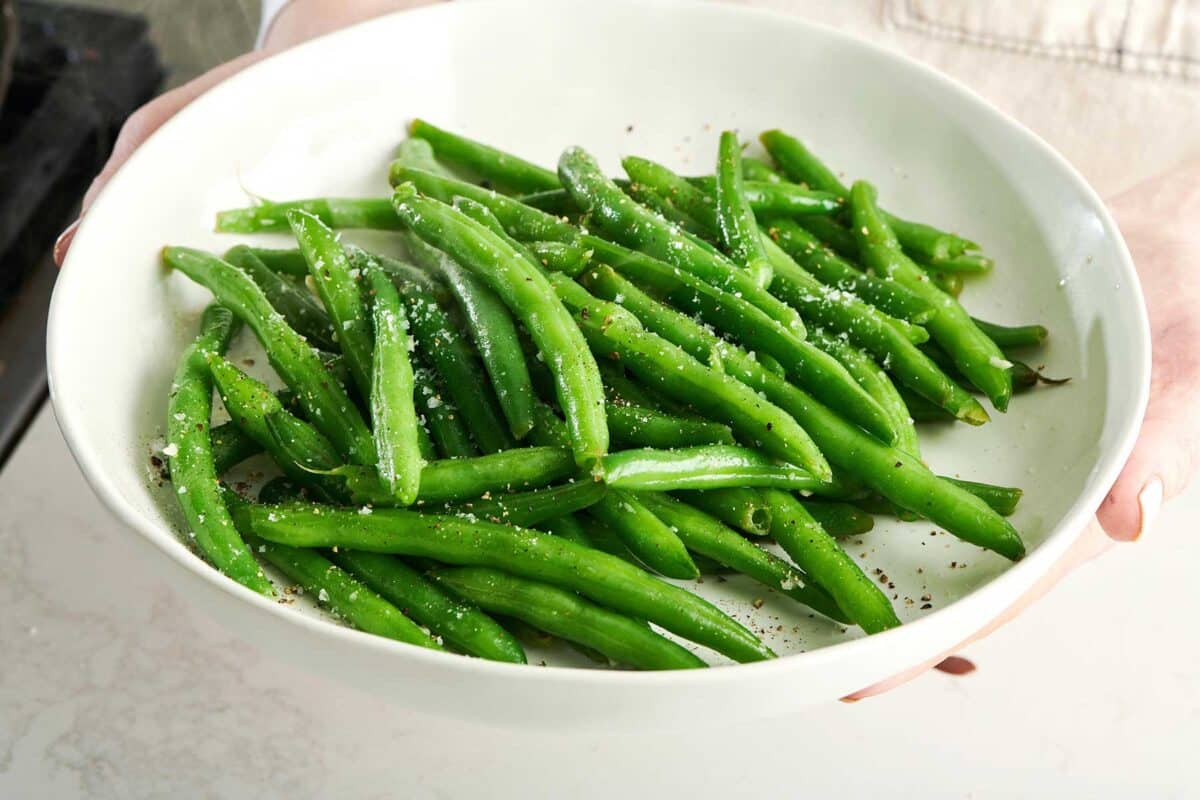
If you’ve ever stood in the produce aisle wondering what to do with that bag of green beans, I feel you, and I’ve got your back. All you need is a skillet, a little butter (or olive oil, if you prefer), a bit of garlic, onions, or shallots, and a splash of broth or water, and you have crisp-tender green beans in less than 10 minutes. This easy recipe highlights the natural flavor of green beans and is simple, fresh, and foolproof. I cannot tell you how many pounds of string beans I have prepared this way, and how much my family loves them. The amount of butter can be dialed up or down (I suggest up).
And these simply cooked green beans go with EVERYTHING! When they are in season during the summer, try them with Grilled Top Sirloin Steaks, Poached Salmon, or New England Baked Haddock. Green beans are a must for Thanksgiving and Christmas; they are perfect with Cornish Hens, Roast Lemon Garlic Turkey Breast, or Beef Filet Tenderloin.
For weeknight dinners, try them with Creamy Garlic Chicken with Potatoes or Pan-Fried Pork Chops.
By signing up, you agree to our Privacy Policy.
What's In This Post?
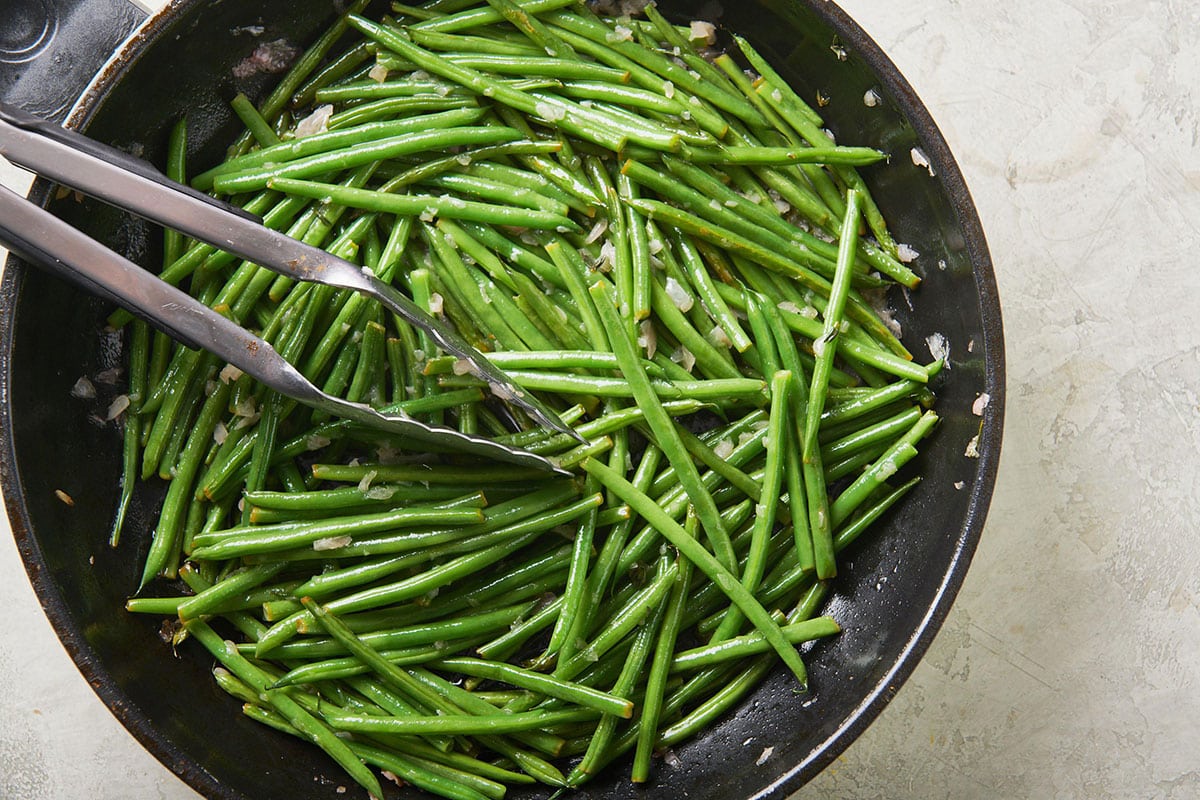
How to Cook Fresh String Beans: How to choose, store, prepare, and cook fresh green beans, plus recipes!
What Are Green Beans?
Green beans, string beans, snap beans, pole beans…whatever the name, this fine vegetable is immensely popular, an evergreen favorite. “Green beans” is the general name; “string beans” was more common years ago when they were bred with a fibrous string that ran along the seam, and the name “snap beans” is used because of the noise they make when snapped. Let’s go with green beans for now, with an occasional string bean thrown in, shall we?
Green beans are long, slender beans that grow above ground. They are eaten fresh, not dried like other types of legume beans. They are also readily available canned and frozen, but when you can start with fresh green beans, especially when they are local and in season, they have a wonderful fresh flavor and appealing texture.
”Blue Lake” green beans are the most common type sold. They’re the ones we grew up on and the ones we most often found at the grocery store. They can be categorized into two different groups: bush or pole beans. If the bean plant needs support to grow, they are classified as pole beans; if the beans can grow on their own without added support, they are classified as bush beans.
Mature string beans are usually 4-6 inches in length and either round or slightly flattened in shape, with some curve in the length. Young string beans, ones picked early, are usually around 3 inches long and skinnier. Most varieties are green, but there are also purple, red, yellow, and streaked varieties.
Raw string beans taste fresh and…kind of green. Yes, green doesn’t exactly describe a flavor, but that’s how I think of it. Actually, string beans don’t have tons of taste on their own; it’s sort of muted and a little starchy, especially when raw.
But cook them in a little broth and butter, add a sprinkle of salt, and they become the most delicious and flavorful vegetable.
Green beans are very healthy! They have a very low calorie count, and they are low in sodium. String beans also have iron, an essential mineral that supports your metabolism, along with antioxidants and Vitamin K (via Medical News Today).
Buying and Choosing Green Beans
String beans are available year-round, but their growing season is May through October, and that is when they are most tender. Green beans are readily available in supermarkets. Look for them at farmers markets (when in season), too.
String beans should be firm, crisp, and bright green.. Make sure they are free of wrinkles, brown spots, and bruises.

How to Prepare Green Beans
String beans are easy to prepare. The ends that have a stem are where they grew from the bush/pole. Remove those by either cutting the end or, my preferred method, pinching right under the stem and peeling downward. That way, if there is any fibrous string attached, it will come off with the motion. If fresh from a farmers market and there is dirt on them, give them a good rinse before using them in a recipe.
Young string beans are best for use in salads and other raw preparations.
How to Blanch Green Beans
Blanching green beans locks in their bright green color and gives them a crisp-tender texture. Bring a large pot of salted water to a boil. Fill a large bowl with ice water and set it to the side. Have a colander (or strainer or slotted spoon) at the ready.

- Trim: For mature green beans, snap off the ends and de-string them (see How to Prepare Green Beans above). Younger, thinner green beans don’t need any trimming.
- Boil: Add the green beans to a pot of boiling water. If you are blanching a large amount of beans, do them in batches so that they don’t lower the temperature of the water too much. Cook 2 to 5 minutes, depending on how crisp or tender you want the beans.
Blanching a Lot of Green Beans
If you are blanching the green beans in batches, you may want to use a slotted spoon (or a spider, which is a large, round, long, handled strainer or skimmer often used in restaurants) if you have one. This will allow you to move the vegetables to the ice bath and then quickly return the water to a boil so you can cook the next batch.
- Plunge into ice bath: Drain or remove with a slotted spoon, then transfer the beans to the bowl of ice water. Let them cool for 1 to 2 minutes, then drain.
- Serve: After blanching, you can enjoy them as is, as part of a crudite platter, in a salad, use them in a cooked recipe, or freeze them.

Why We Love Green Beans

Part of the allure of string beans is that they are so versatile. They are perfect accompaniments but can also hold the spotlight. They can be prepared with an Asian flair (think of Thai Green Beans or Vietnamese Green Beans), as easily as Italian (try Green Beans with Gremolata). Green beans are very popular throughout the U.S., especially in the South.
String beans can be boiled, sautéed, stir-fried, fried, steamed, roasted, or even microwaved. My grandfather loved them floppy and overcooked, loaded with butter, while my sister prefers them tender yet crisp, but also loaded with butter (ah, you can see the genetics at work!).
Slice them up raw or cooked and cooled, and mix them into any kind of salad. Sauté them simply with citrus and garlic for a delicious side dish, as directed below. Or let them shine in a Green Bean Nicoise Salad. Also, see Air Fryer Green Beans.
Below is the simplest recipe for sautéed green beans, prepared very simply with garlic, salt, pepper, and some olive oil. You can use broth or water to steam them.

How to Cook Fresh Green Beans on the Stove
- Sauté the green beans: In a large skillet, melt the butter or heat the oil over medium heat. (Use oil for a vegan green bean dish.) Add the green beans and the garlic and toss in the pan for 2 minutes, until you can smell the garlic.
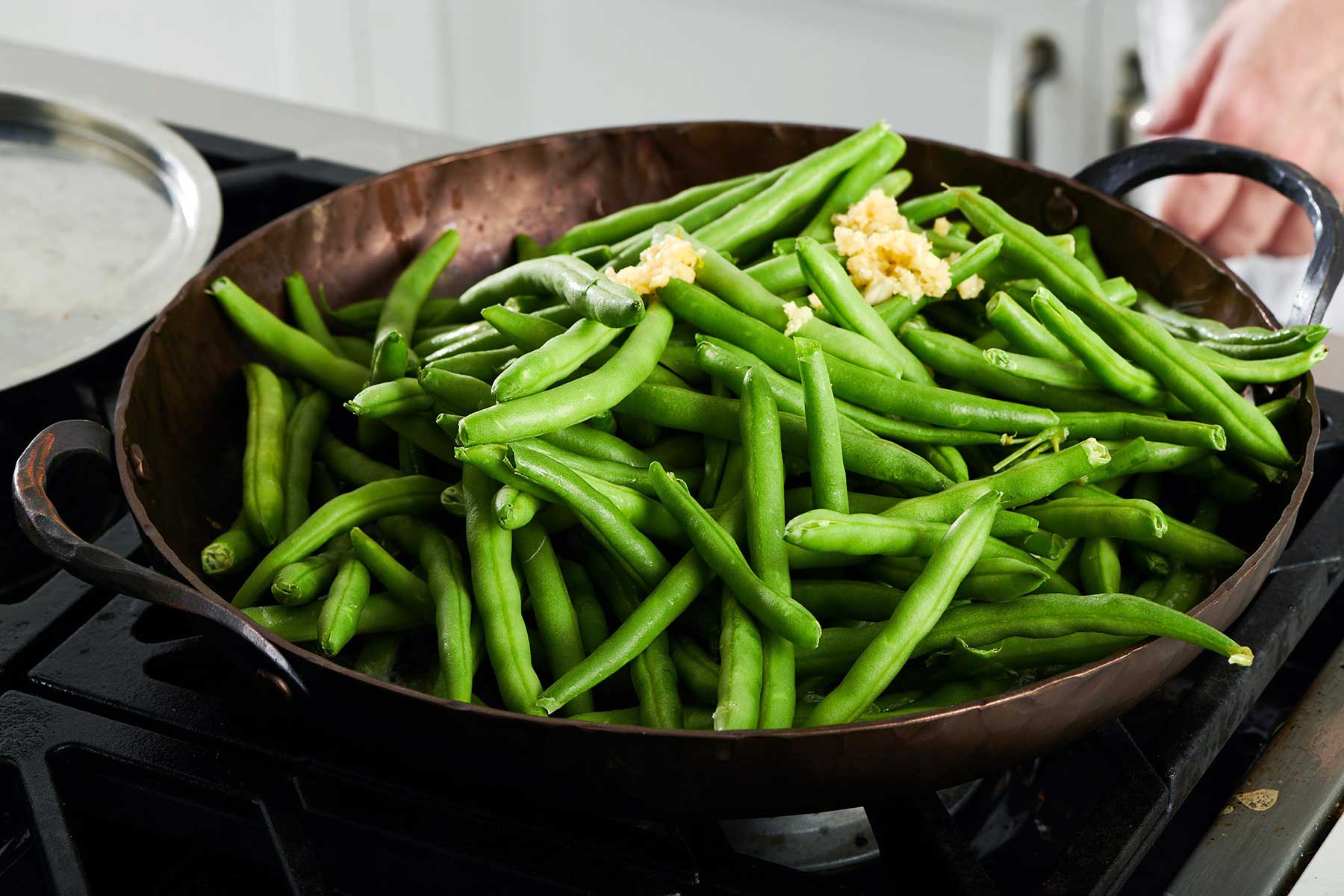
- Steam the green beans: Add the broth or water, raise the heat to high, and bring to a simmer. Cover the pot tightly, adjust the heat a bit lower, and simmer until the beans are crisp-tender, about 3 minutes.
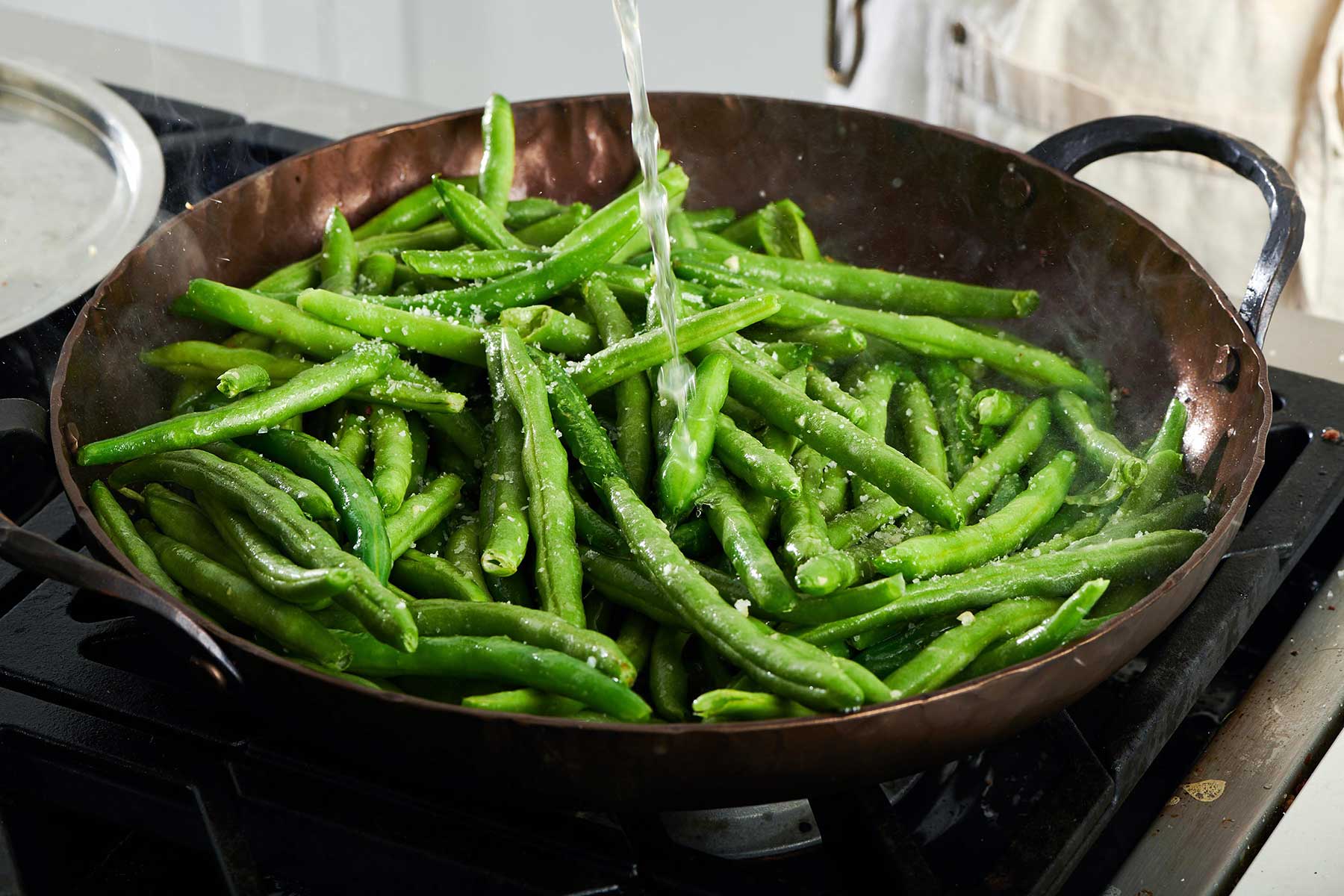
- Finish cooking the green beans: Remove the lid and cook, tossing occasionally, until the broth is nearly evaporated and the beans are tender, about 4 minutes longer.

- Season and serve: Taste and add salt and pepper as needed. Turn the beans into a serving bowl and serve hot, warm, or room temperature.
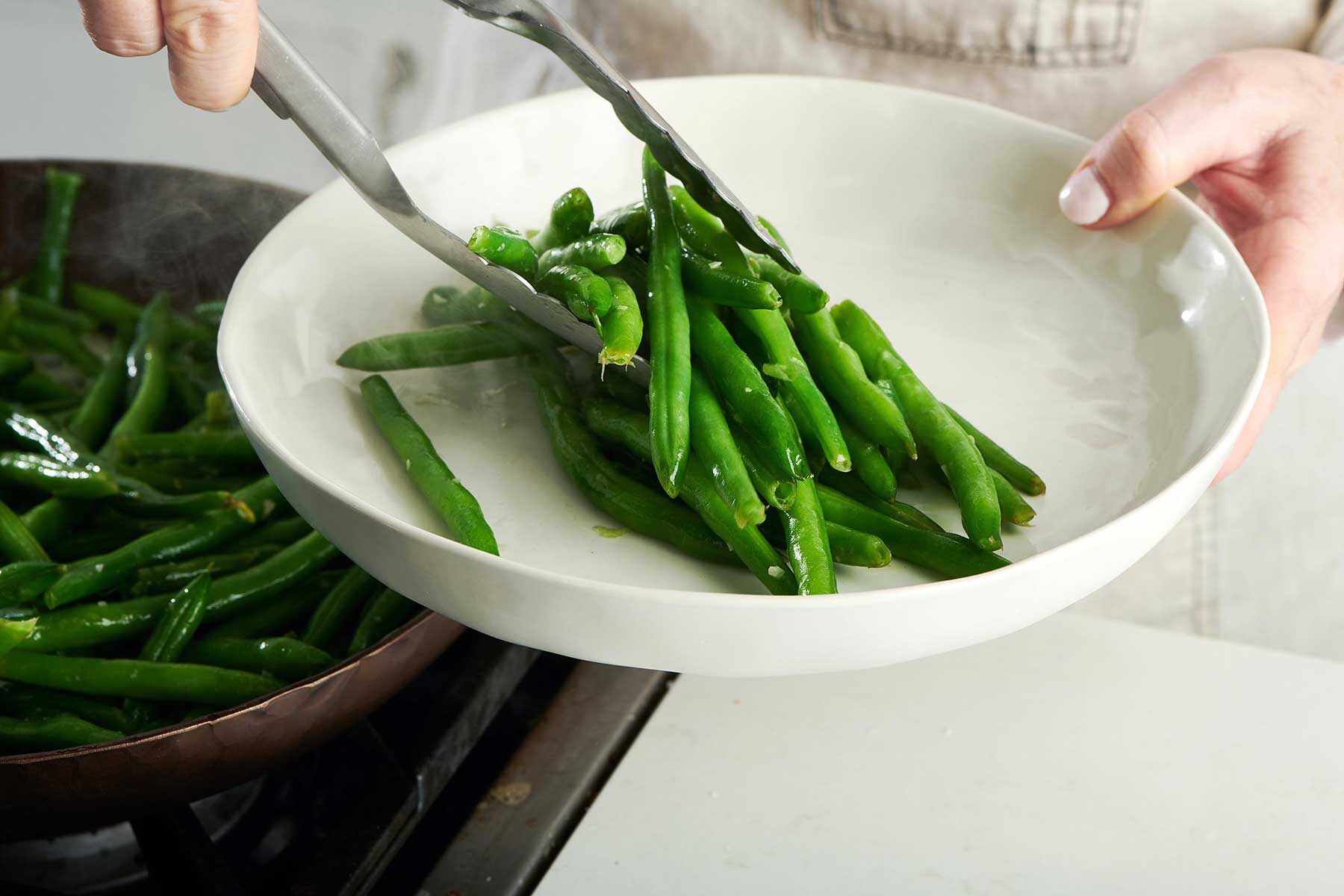
How to Store Green Beans
Unwashed green beans can be stored in the refrigerator in an air-tight container or bag for up to 7 days. If you wash them, they will last for less time, as moisture will make them go bad faster.
How to Freeze Green Beans
Raw string beans also freeze nicely, but do wash and trim them before freezing, even cutting them into smaller pieces if desired. If you really want to retain their texture and bright color for when you cook them, give them a quick blanch in boiling water.
Before freezing, blanch green beans for 30 to 60 seconds (see above). Once the beans are cool, pat them very dry with a clean dish towel. Place them in a freezer-proof sealable bag. Press out any excess air, and seal the bag. Label with the name and date, and freeze for up to 6 months.
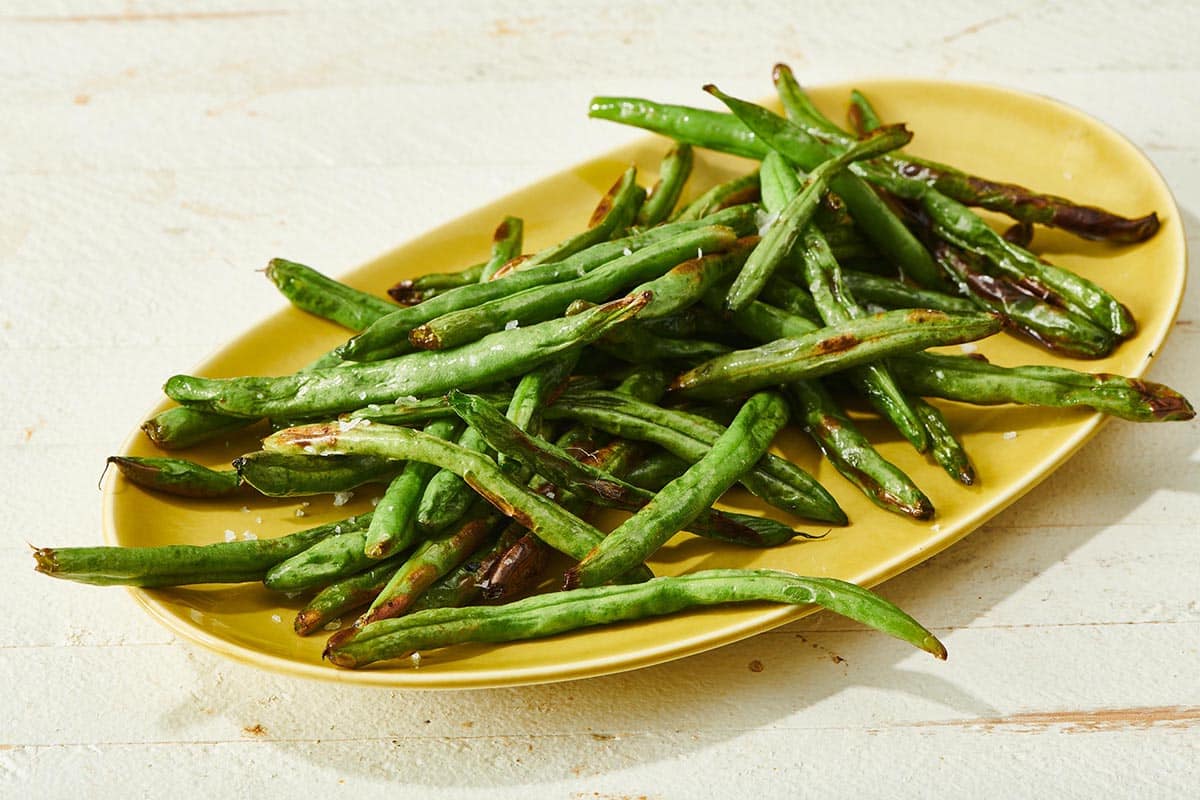
FAQs
Depending on how crisp-tender or tender you like them, green beans should be cooked on the stove for a total of 6 to 10 minutes. I like to sauté them first with a bit of garlic and oil or butter to coat them, then add some liquid and steam then the rest of the way through. Once the green beans have become crisp-tender, you’ll want to remove the lid from the pan and cook them until the liquid evaporates. This allows the butter or oil to form a lovely glaze on the green beans.
Test one every few minutes to see when they are done to your liking. Know that they will continue to soften a bit once you remove them from the heat, so don’t let them get too soft.
You can cook frozen green beans in the same way that you cook fresh ones, and you don’t even need to defrost them. If the green beans are packaged, just sauté and then steam them just as directed in this recipe.
The same is true if you froze your own green beans. If the green beans were blanched before freezing, they will take about the same time as fresh green beans. If not, you may need to add a few more minutes of steaming to allow them to become tender.
What to Serve With Green Beans
Pin this now to find it later
Pin It
Sautéed Green Beans
Ingredients
- 2 tablespoons unsalted butter or olive oil
- 1 pound green beans, (trimmed)
- 1 small garlic clove (minced)
- ½ cup low-sodium vegetable or chicken broth (or water)
- Kosher salt and freshly ground black pepper (to taste)
Instructions
- In a large skillet, melt the butter or heat the oil over medium heat. Add the green beans and the garlic and toss in the pan for 2 minutes, until you can smell the garlic. Add the broth or water, raise the heat to high, and bring to a simmer.
- Cover the pot tightly, adjust the heat a bit lower, and simmer until the beans are crisp-tender, about 3 minutes. Remove the lid and cook, tossing occasionally, until the broth is nearly evaporated and the beans are tender, about 4 minutes longer. Taste and add salt and pepper as needed.
- Turn the beans into a serving bowl and serve hot, warm, or room temperature.
Notes
- To trim green beans, remove the ends by either cutting them off or pinching right under the stem and peeling downward. That way, if there is any fibrous string attached, it will come off.
- If they are very young and tender, you might not need to string them.
- If fresh from a farmers market and there is dirt on them, give them a good rinse before using them in a recipe.




